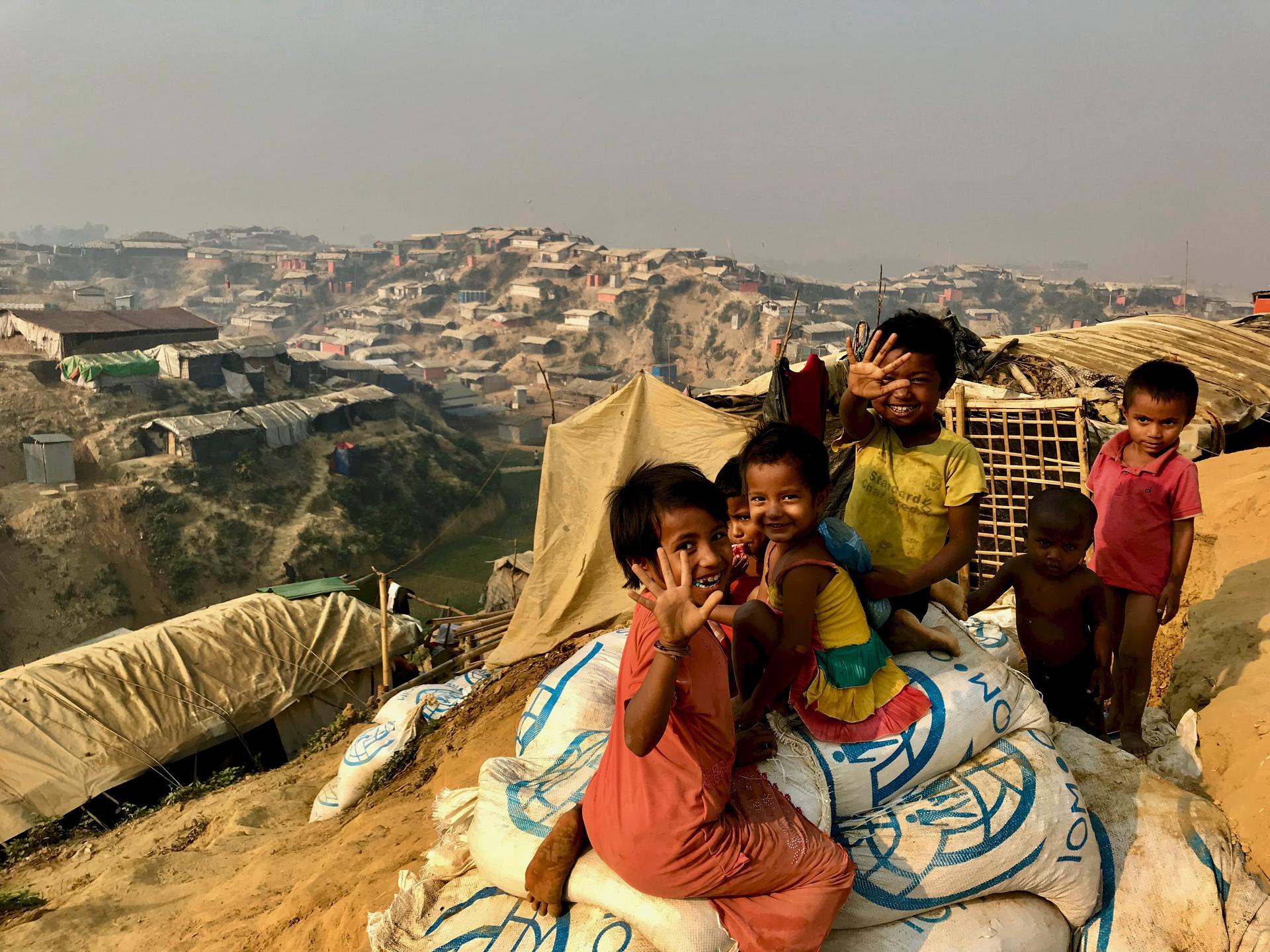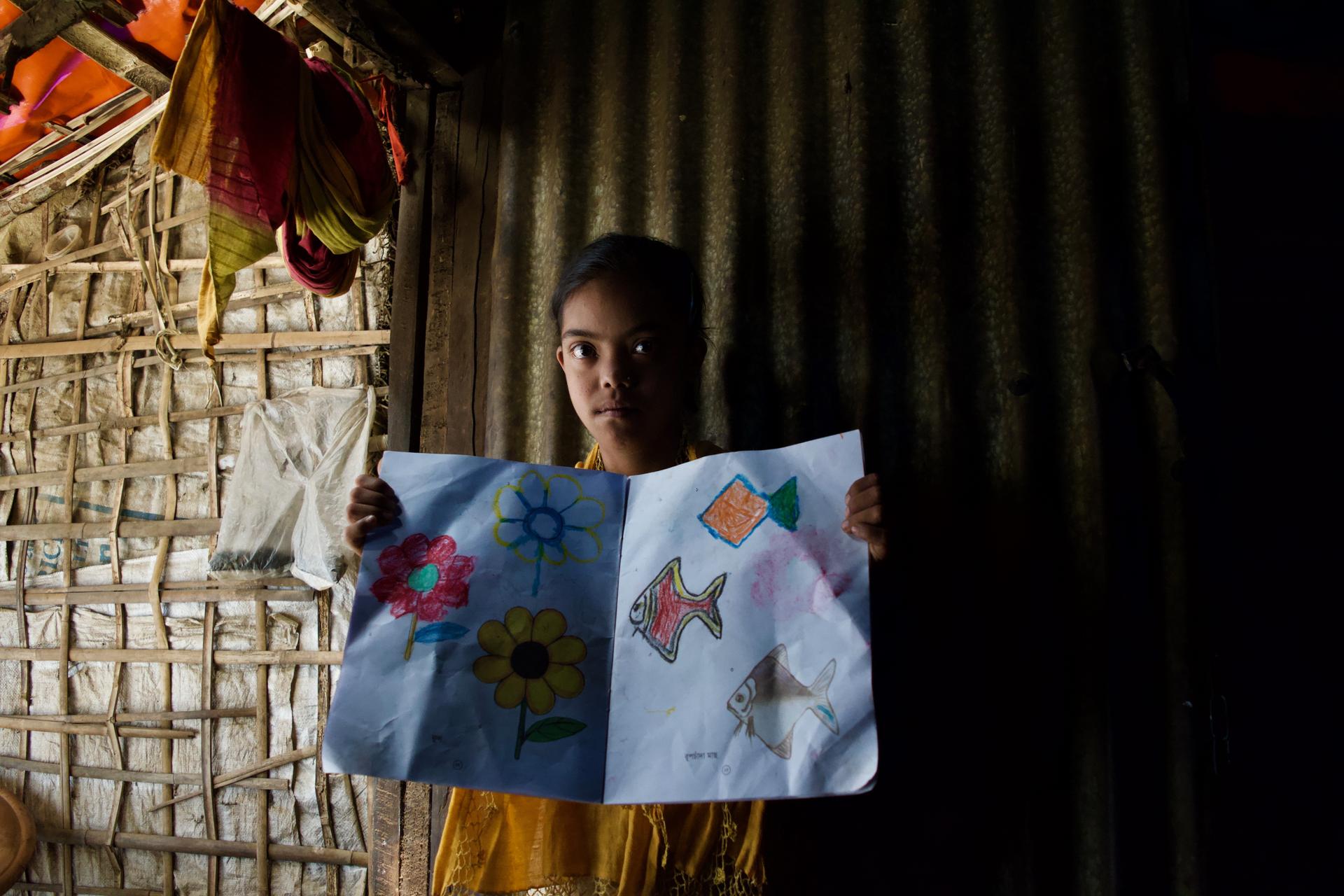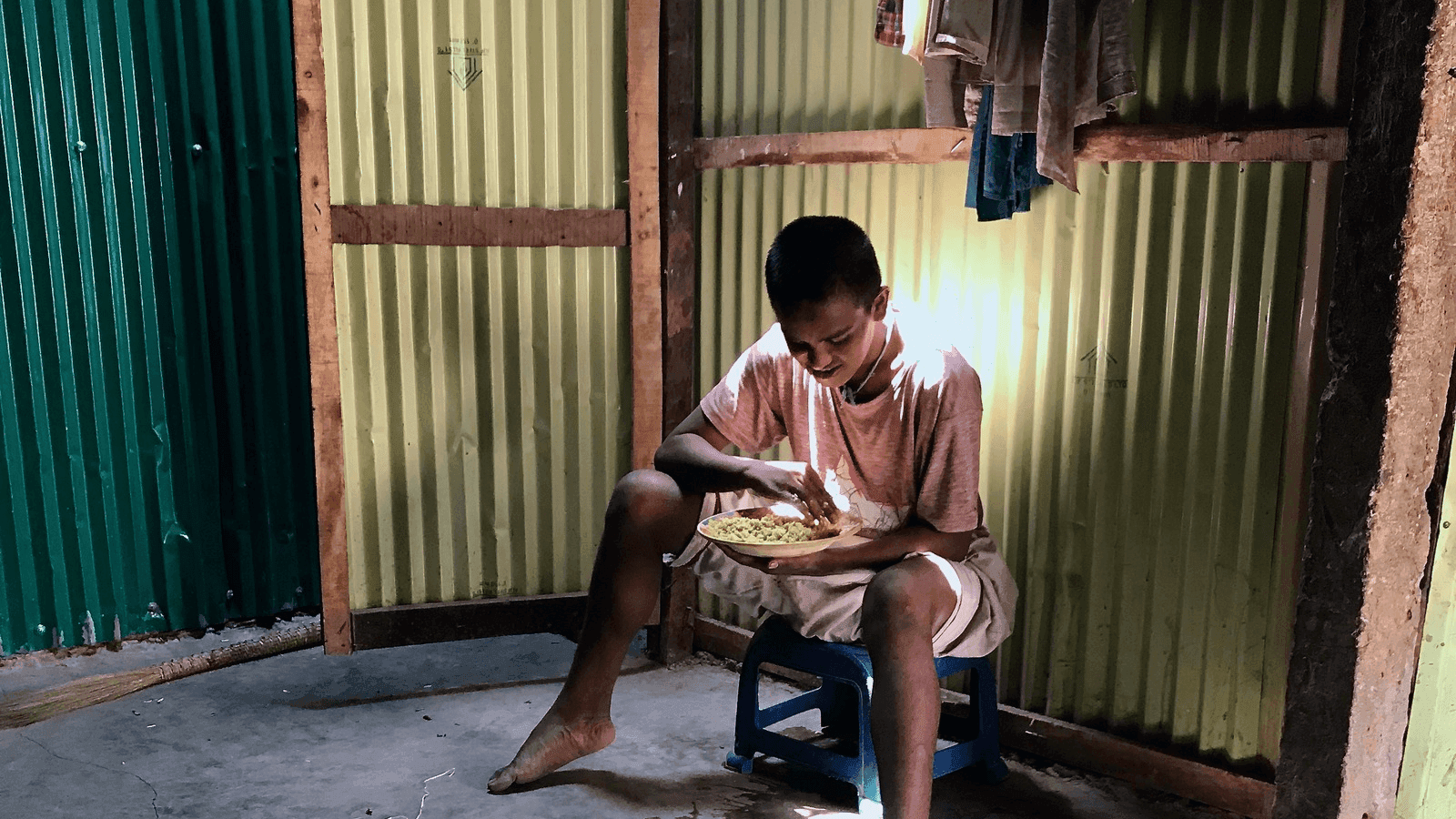Help is scarce for Rohingya children with intellectual disabilities
Anayetullah is an 18-year-old Rohingya refugee with intellectual disabilities. Proper care is difficult to find in the refugee camp, and he is currently enrolled in preschool.
Anayetullah, 18, is a growing teenager. For lunch, he helps himself to three large plates of fried rice. But as he sits on a blue plastic step stool to eat, clues emerge that Anayetullah might be different from other children. He teeters back and forth and repetitively centers his rice in a triangle with his hands before scooping up a handful to eat.
Anayetullah and his mother, 39-year-old Zohura Khatun, are Rohingya — a stateless Muslim minority from Myanmar. Since the late 1970s, intermittent religious violence in predominantly Buddhist Myanmar has sent the Rohingya fleeing for their lives into Bangladesh. Today, more than 900,000 Rohingya live in shelters and nearby host communities in southeastern Bangladesh.
Inside his makeshift home made of bamboo and metal sheets in Kutupalong, the largest Rohingya refugee camp in Bangladesh, Anayetullah is safe. But he is not thriving; he’s intellectually disabled and treatment is limited in the refugee camp. Because he is nonverbal, other children — even those who are younger — treat him poorly. “He has no friends. He tries to play with them, but after some time, he just tries to beat them,” says his mother.
Related: One doctor’s experience on a ‘medical mission’ to treat Rohingya refugees
In any situation, children with mental and physical disabilities face challenges. But it’s particularly difficult for Rohingya kids living in overcrowded refugee camps — where getting sufficient food, clean water and an education is already a challenge and the medical care is basic at best.
Related: With already tenuous housing, the looming monsoon season threatens Rohingya refugee camps
While those with physical disabilities are much more visible to spot and assist, it’s more challenging for children like Anayetullah who have intellectual disabilities to get diagnosed and treated. Even though several NGOs are working to support the refugees with disabilities inside the camps, some people inevitably fall through the cracks. The parents of these children are already living in uncertainty, especially now in the midst of monsoon season — and having a child with developmental disabilities only compounds on that. Some of the parents told PRI that they didn’t think they were finding enough help within the camps. Eager for answers, they’ve turned to shamans as well as doctors outside the camps.
Limited facilities impede treatments
Zohura Khatun is one of those parents that wants more help for her son. Since Anayetullah was 7, she knew he was different. “He would look at the roof — or somewhere above him — and start trembling. Then he would fall down, and he cannot move his body,” she says.

More than 500,000 of the Rohingya in the refugee camps are children. According to data collected by Humanity & Inclusion (HI), an organization that works with disabled kids in the Rohingya camps and worldwide, approximately 3 percent of the kids that HI helps are mentally, intellectually or developmentally disabled. It’s difficult to get a precise number, says Sophie Dechaux, country director in Bangladesh for HI. “People hide their disability because they are afraid of the stigma. And it’s labor intensive: You need long one-on-one exchanges to detect mental issues.”
Related: What it’s like to live in the world’s toughest places for women
Inside the Rohingya camps, there are no developmental pediatricians to diagnose and treat the children who do have such physical and mental disabilities. Ultimately, this — and the lack of proper facilities — precludes families from getting the proper treatment for their children.
In ongoing humanitarian situations like the Rohingya crisis, it’s rare to hear about developmental pediatricians being deployed to diagnose and treat children with intellectual disabilities, says Randi Hagerman, a pediatrician who specializes in developmental disorders at the UC Davis MIND Institute. “People are focused on life-sustaining measures — getting enough water, sanitation and food to these populations — and not focusing on developmental issues. I think it’s a good idea [to get these specialists], it’s just a secondary priority to saving lives.”
And because so many of the refugees are children, “[the Rohingya crisis] is really a children’s emergency,” says Simon Pickup, a communications specialist at the humanitarian organization, UNICEF. “The reality is that their childhood is going to be spent inside these camps, and we only get one chance to make it right. We’ll get an entire lost generation if children are left undiagnosed and untreated.”
Rohingya children and adults with all types of disabilities receive aid in the form of psychological support, child-safe spaces and basic medical care, primarily from NGOs working in the camps.
“The gap that exists in society regarding people with a disability is greatly amplified when there’s a disaster or conflict,” says Gordon Rattay, an emergency communications coordinator for CBM, which helps populations with disabilities. “Aid agencies are addressing this problem, and things are changing slowly, but it’s still a huge gap.”
Related: ‘A soldier cut off her breast:’ Rohingya survivors recount atrocities
Inside Kutupalong, where Zohura Khatun and her family have lived for the past 27 years, children seem to be everywhere. Some families have been there since the early ’90s, which means the refugee camp is the only world these children know. At the sight of foreigners, kids clamor and follow them around, yelling “Hello!” “How are you?” or “I’m fine!” — three English phrases they learn in school.
Children with disabilities are not as visible. Like Anayetullah, who mostly stays near his mother, 16-year-old Zaynab Bahar also stays close to home.
Parents turn to shamans
Zaynab Bahar is non-verbal and communicates primarily with her parents by pointing. Her mother, Fatema Khatun, 54, was concerned about Zaynab Bahar early in her childhood.
“A child can usually speak a little around 2 or 3 years old,” Fatema Khatun says. “But she could only speak some words, like ‘mama’ and ‘papa.’ When she was 5, I easily saw she was abnormal. Children younger than her could speak, walk and do everything normally, but she could not.”

The stigma of having an intellectually disabled child also burdens the parents.
“The other Rohingya in the camp hate my daughter,” says Fatema Khatun. “They say I’ve given birth to an abnormal kid. They say sometimes she’s crazy or foolish or mad.”
Fatema Khatun says she cried all the time because there was no one to help her and her husband care for their daughter.
Among the Rohingya, there’s a common belief that disabilities are caused by God.
“Most parents take their disabled kids to a shaman,” says Mohammed Imran, a former elected representative of Kutupalong who had discussed their needs with aid groups. The Rohingya, while not opposed to seeing doctors, tend to look to traditional healers as a first resort when they believe their ailments are spiritual in nature.
Hamida Begum, 31, brought her 5-year-old daughter, Jannatul Bokiya, to a shaman last year. When Jannatul Bokiya was 7 months old, her mother realized that she couldn’t eat, sit or move properly. Later, Jannatul Bokiya started having seizures and her mother became concerned that the seizures were part of a bigger issue. The shaman gave the girl two metal cylinders to wear around her neck to prevent her from such episodes.
“She doesn’t like to wear the necklace,” Hamida Begum attests. But she says that she thinks it reduces the frequency of her daughter’s seizures. (Jannatul Bokiya isn’t taking any medication.)
Specialized care lacking
Although basic medical care in the camps exists, more specialized care for children with intellectual disabilities is limited. The best resource for disabled children in the camps is HI’s “Growing Together” program, which encourages play among children with disabilities and to help parents better interact with their kids. By having children with and without disabilities interact and play together, HI hopes to increase the social skills of children with intellectual disabilities. HI also provides rehabilitation services, psychological support, and child-friendly spaces for those families seeking support. Since Jannatul Bokiya was having trouble learning to walk, HI gave her mother some pillars to put around their home so she could hold on to them as she walked around.
But there’s no method for intellectually disabled children to be diagnosed and treated inside the camps. And without proper diagnoses and the correct interventions early on in development, many children won’t reach their full potential, says Katherine Yun, a pediatrician at the Children’s Hospital of Philadelphia who has worked with immigrants and refugees for about 15 years.
Anayetullah, for instance, at 18, is currently enrolled in preschool. Zaynab Batar, 16, is enrolled in third grade. According to her mom, she’s not learning. “When I ask the teachers why you would promote her grade by grade, they said if she sees some other children are talking or playing, then she could learn from them.”
Although an ideal solution would be to have children of the same age learning together, it’s not so strange for older children with intellectual disabilities learning in the same class as younger children, says Dechaux of HI.
“[Anayetullah’s] cognitive ability might be at the same level as that of pre-schoolers, so there could be a benefit from him learning in a stimulating learning environment. [The teachers] would also need to be very careful that other children aren’t at risk of being hurt. It’s definitely not an ideal situation,” she says.
But even in these low-resource settings, parents want answers — a perhaps impossible dream.
Zohura Khatun tried looking for treatment for Anayetullah about nine years ago. When she took him to the camp’s Refugee Health Unit, the staff gave him tablets of carbamazepine, a drug intended to treat epilepsy. Anayetullah has been taking it daily since then, but there’s been no progress.
“The drugs aren’t helping. Day by day, I see his condition is deteriorating,” Zohura Khatun laments.
Besides the Refugee Health Unit, she has not found medical treatment elsewhere in the camps. In 2015, she finally brought Anayetullah via local transportation to a hospital a six-hour drive away and received a diagnosis from a doctor: epilepsy and cerebral palsy.
Fatema Khatun has also searched high and low to see if any clinics or non-governmental organizations could diagnose her daughter. She went to the refugee health unit run by Médecins Sans Frontières (Doctors Without Borders) and to HI’s facilities but couldn’t find anyone who could help.
“I requested to a HI doctor to get a brain test. I wanted to at least try for my daughter,” she says. “But they said they do not have a doctor and said there was no need for a test.”
Still, Fatema Khatun believes that her daughter’s situation is critical. Without being properly educated about intellectual disabilities, she believes that a diagnosis would at least give her some answers. In early April, she was planning to go around the camp and beg for money during Ramadan so she could bring her daughter to a hospital for a proper diagnosis. “If I can get money, I will go to the hospital to get a brain test, to find out exactly what the problem is. If this happens before I die, I will be very thankful.”
